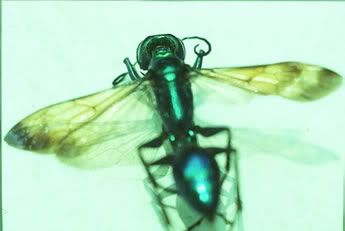
A while ago I did a 'serious' post about discovering the backstory to a beach I ate a sandwich on in Western Australia (here). Time for another one, this one prompted by a science article I read in another blog - the excellent, and award-winning Loom. You might not want to eat whilst reading this, as it's about insects.
They have always fascinated me, and the recent BBC Natural History series Life in the Undergrowth proved yet again how incredibly they behave. The other week I also saw a programme about Butcher Ants in Africa - the marauding wave of tiny killers that rampage along, shredding anything hapless enough to get in their way. I'm not about to get drawn into the Evolution/Intelligent Design argument here - as most people who know me know I'm firmly on Darwin's side of the fence (throwing a frisbee around in his garden, probably). But I can understand how some animal behaviour is seen by Creationists as proof that evolution couldn't come up with something as complex. The two examples below could be seen as being so utterly complicated they couldn't possibly develop over time. But I think they are the opposite - evolution in action.
The first belongs to the Butcher Ants, and for me is pretty much cast-iron proof that evolution happens. When the stream of ants encounters a creature that can't escape, they swarm all over it and nibble it to pieces. On the programme they found a slug - easy pickings, you might think. Well, no, as the slug immediately splurged slime all over the place, drowning any ants nearby, and giving it a private moat. If this had saved the slug in the past, the ants have now discovered - learned - a way around it. Incredibly, each ant goes away and picks up a jawful of earth. As the smug slug sits in his pool of gunge, each individual ant drops it's soil into the slime. What are they doing? They are soaking up the liquid. Eventually, so many ants have done this, the mucus puddle has dried up and the ants swarm all over the now hapless slug, tearing it to pieces. This is evolution happening in front of us. The slugs have developed a protective measure against the ants, and the ants have learned a way around it. Now the slugs that change their behaviour to win back the advantage (by producing fiery slime, or something) will survive, and those that can't, won't. This is Natural Selection in action.
The second incidence stunned even me - and when it comes to invertebrates, I take some stunning. Unless it involves large spiders. This one involves a wasp - Ampulex compressa, which has to lay eggs inside a cockroach (I did warn you). Now if it stabbed a healthy living roach, and let it run off until the egg hatched, the host might die or get eaten - killing the wasp larvae at the same time. So the wasp has to incapacitate the cockroach, and hide it away. Some parasitic wasps sting their victim and drag it bodily back to the wasp's burrow - but Ampulex is too small, so has to do things a little differently. It prefers to get the cockroach back to it's own burrow - but of course they wouldn't exactly volunteer. So what the wasp does is astonishing. It stings the roach to stun it, then stings it again in the back of the head. Not just anywhere - it probes around exactly, until it finds the specific part of the roach brain covering escape reflexes.
Driving it's stinger home, the wasp removes the 'fear' part of the brain (for want of a better expression), and disables the insect so it can't walk unaided. The cockroach sits there obediently. So how does the wasp get to the burrow? It grabs hold of the roach's antennae and walks it there, like a dog. The roach follows, walking to it's home, and the wasp pulls it gently along, but lets it instinctively go home. There, the wasp stings it again, injects the egg, and walls the hole closed. The larvae then has a safe, protected place to develop, and a first meal on hand. In fact, the baby wasp is born inside it's first meal - like being born inside a giant pie. So the Ampulex wasp has overcome the problem of being too small to manipulate a massive cockroach by evolving the means to make the cockroach manipulate itself like a zombie.
Just think about the changes in behaviour necessary to give the wasp that ability. Discovering where to sting the roach without killing it, what part of the brain to aim for to make it subserviant, even what species of cockroach to prey on. Survival of the fittest. And this isn't a complex mammalian brain making these decisions - this is a wasp half the size of your little finger. The one downside of evolution, is that it happens so sloooooowly we can't see all these variations, all the tiny steps taken for the behaviour to develop. But I think we can see enough. Each stage of the battles between ant and slug, wasp and cockroach is part of this development. Now the ants and wasps have the upper hand - but if the cockroach develops a thicker head, the wasp's stinger might not reach. This would be the next stage. This is evolution in action - and I find it utterly, utterly fascinating.
For more about Ampulex compressa, the excellent article can be read here. It also has photos of the wasp stinging the cockroach.